









Ali Cherri, The Crow, the Owl and Other Birds, 2018
Five etchings on paper, oak frame
29 x 21 cm (each). Edition of 5 + 2 AP. Available: 3/5
Ali Cherri, The Crow, the Owl and Other Birds, 2018
Five etchings on paper, oak frame
29 x 21 cm (each). Edition of 5 + 2 AP. Available: 3/5
Ali Cherri, Grafting (F), 2018.
Terracotta statue representing a sphinx, Nok Civilization, ca. 500 BCE, taxidermy head of a roe deer, ca. 1950
36 x 13 cm. Unique
Ali Cherri, Grafting (F), 2018.
Terracotta statue representing a sphinx, Nok Civilization, ca. 500 BCE, taxidermy head of a roe deer, ca. 1950
36 x 13 cm. Unique
Ali Cherri, Grafting (J) [detail], 2019.
Head of Lobi protection figure, sandstone Buddha bust from Thailand, Ayuthaya Kingdom, 15th century, wooden base
40 x 22 x 15 cm (without base). Unique
Ali Cherri, Grafting (J) [detail], 2019.
Head of Lobi protection figure, sandstone Buddha bust from Thailand, Ayuthaya Kingdom, 15th century, wooden base
40 x 22 x 15 cm (without base). Unique
Ali Cherri, Hybrids (E), 2018.
Indus Valley painted terracotta bowl, porcelain fragment, granite base
18 x 12 x 6 cm. Unique
Ali Cherri, Hybrids (E), 2018.
Indus Valley painted terracotta bowl, porcelain fragment, granite base
18 x 12 x 6 cm. Unique
James Webb, I do not live in this world alone, but in a thousand worlds (A Comet is Coming), 2018.
Three texts written on soluble paper, dissolved in water, and presented in 3 glass vials (found objects)
20 x 40 x 18 cm. Unique
James Webb, I do not live in this world alone, but in a thousand worlds (A Comet is Coming), 2018.
Three texts written on soluble paper, dissolved in water, and presented in 3 glass vials (found objects)
20 x 40 x 18 cm. Unique
James Webb, I do not live in this world alone, but in a thousand worlds (Alma’s story), 2019.
One text written on soluble paper, dissolved in water, and presented in a glass vial (found object)
16 x 10 (diam.) cm. Unique
James Webb, I do not live in this world alone, but in a thousand worlds (Alma’s story), 2019.
One text written on soluble paper, dissolved in water, and presented in a glass vial (found object)
16 x 10 (diam.) cm. Unique
James Webb, There is a light that never goes out (Farsi), 2020.
8mm glass tubing in ‘sky white’
Site-specific / 30 x 300 cm approx. Edition of 1 + 1 AP. Available: 1/1
James Webb, There is a light that never goes out (Farsi), 2020.
8mm glass tubing in ‘sky white’
Site-specific / 30 x 300 cm approx. Edition of 1 + 1 AP. Available: 1/1
Sammy Baloji. Hans Himmelheber, The long building of the circumcision camp can be seen behind the mask, DR Congo, Pende region, 1939, scan of the inside of a Songye power figure, and your reflection in the mirror, 2020
UV Print on mirror 4 mm, frame in polished brushed brass
204 x 83 cm. Edition of 5 + 1 AP. Available: 1/5
Sammy Baloji. Hans Himmelheber, The long building of the circumcision camp can be seen behind the mask, DR Congo, Pende region, 1939, scan of the inside of a Songye power figure, and your reflection in the mirror, 2020
UV Print on mirror 4 mm, frame in polished brushed brass
204 x 83 cm. Edition of 5 + 1 AP. Available: 1/5
Sammy Baloji, Hans Himmelheber, Portrait of his shadow, DR Congo, Kingulu, June 18, 1938, scan of a Chalcopyrite from Kipushi mine, and your reflection in the mirror, 2020
UV Print on mirror 4 mm, frame in polished brushed brass
50 x 50 cm. Edition of 5 + 1 AP. Available: 3/5
Sammy Baloji, Hans Himmelheber, Portrait of his shadow, DR Congo, Kingulu, June 18, 1938, scan of a Chalcopyrite from Kipushi mine, and your reflection in the mirror, 2020
UV Print on mirror 4 mm, frame in polished brushed brass
50 x 50 cm. Edition of 5 + 1 AP. Available: 3/5
Sammy Baloji, Hans Himmelheber, Monument, DR Congo, Kinshasa, 1938, scan of a Chalcopyrite from Kipushi mine, and your reflection in the mirror, 2020
UV Print on mirror 4 mm, frame in polished brushed brass
50 x 70 cm. Edition of 5 + 1 AP. Available: 2/5
Sammy Baloji, Hans Himmelheber, Monument, DR Congo, Kinshasa, 1938, scan of a Chalcopyrite from Kipushi mine, and your reflection in the mirror, 2020
UV Print on mirror 4 mm, frame in polished brushed brass
50 x 70 cm. Edition of 5 + 1 AP. Available: 2/5

Ali Cherri, The Crow, the Owl and Other Birds, 2018
Five etchings on paper, oak frame
29 x 21 cm (each). Edition of 5 + 2 AP. Available: 3/5
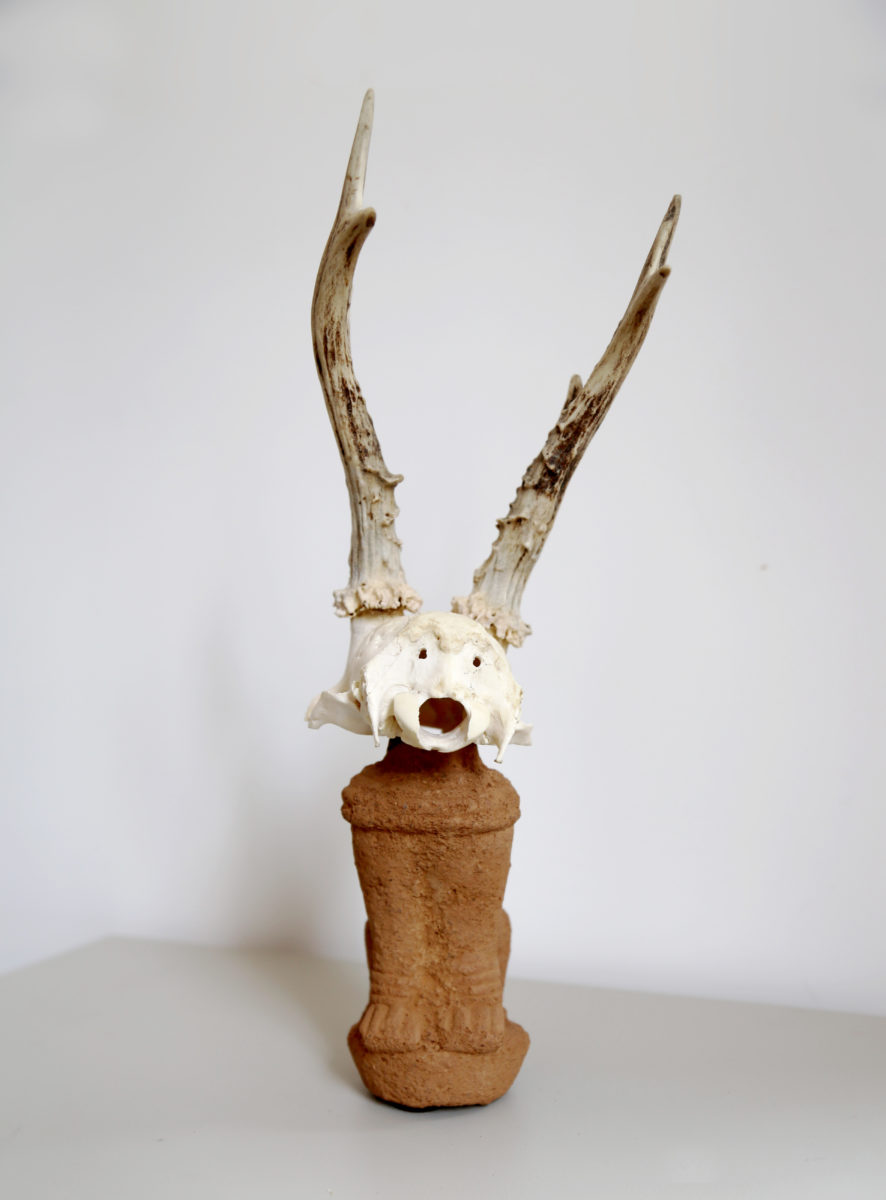
Ali Cherri, Grafting (F), 2018.
Terracotta statue representing a sphinx, Nok Civilization, ca. 500 BCE, taxidermy head of a roe deer, ca. 1950
36 x 13 cm. Unique
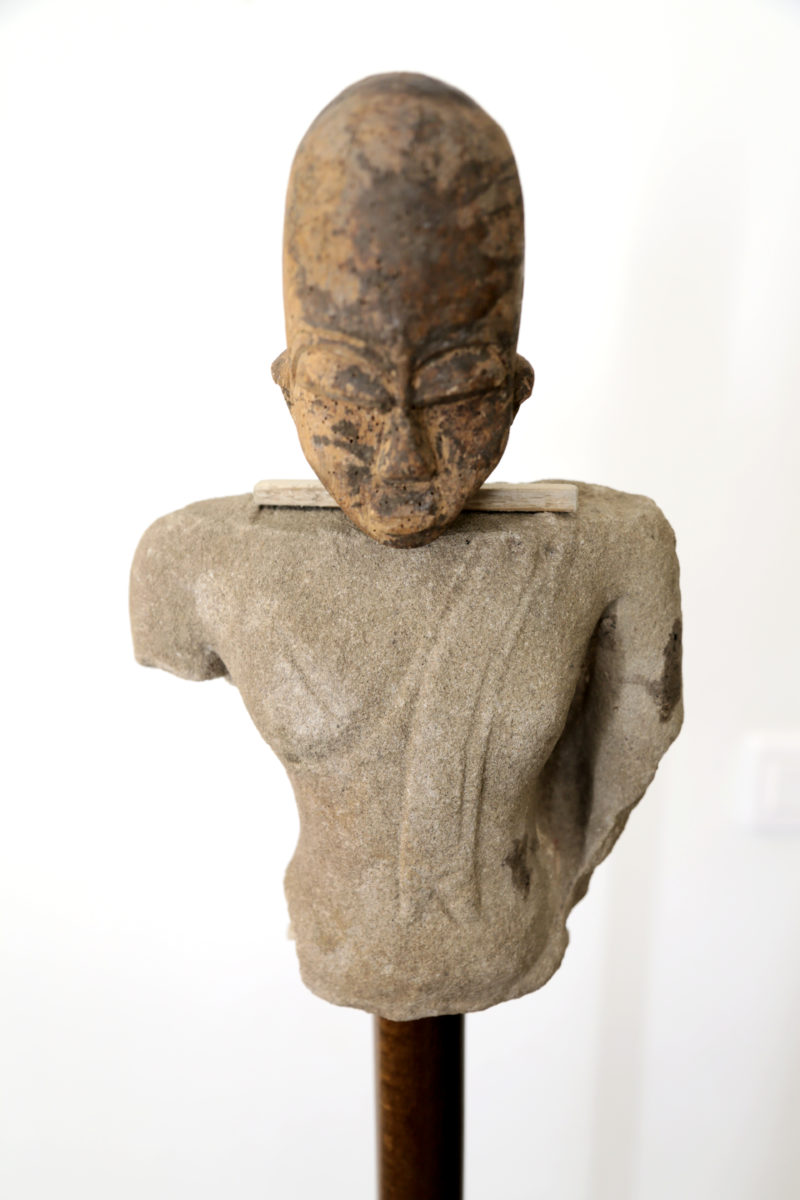
Ali Cherri, Grafting (J) [detail], 2019.
Head of Lobi protection figure, sandstone Buddha bust from Thailand, Ayuthaya Kingdom, 15th century, wooden base
40 x 22 x 15 cm (without base). Unique
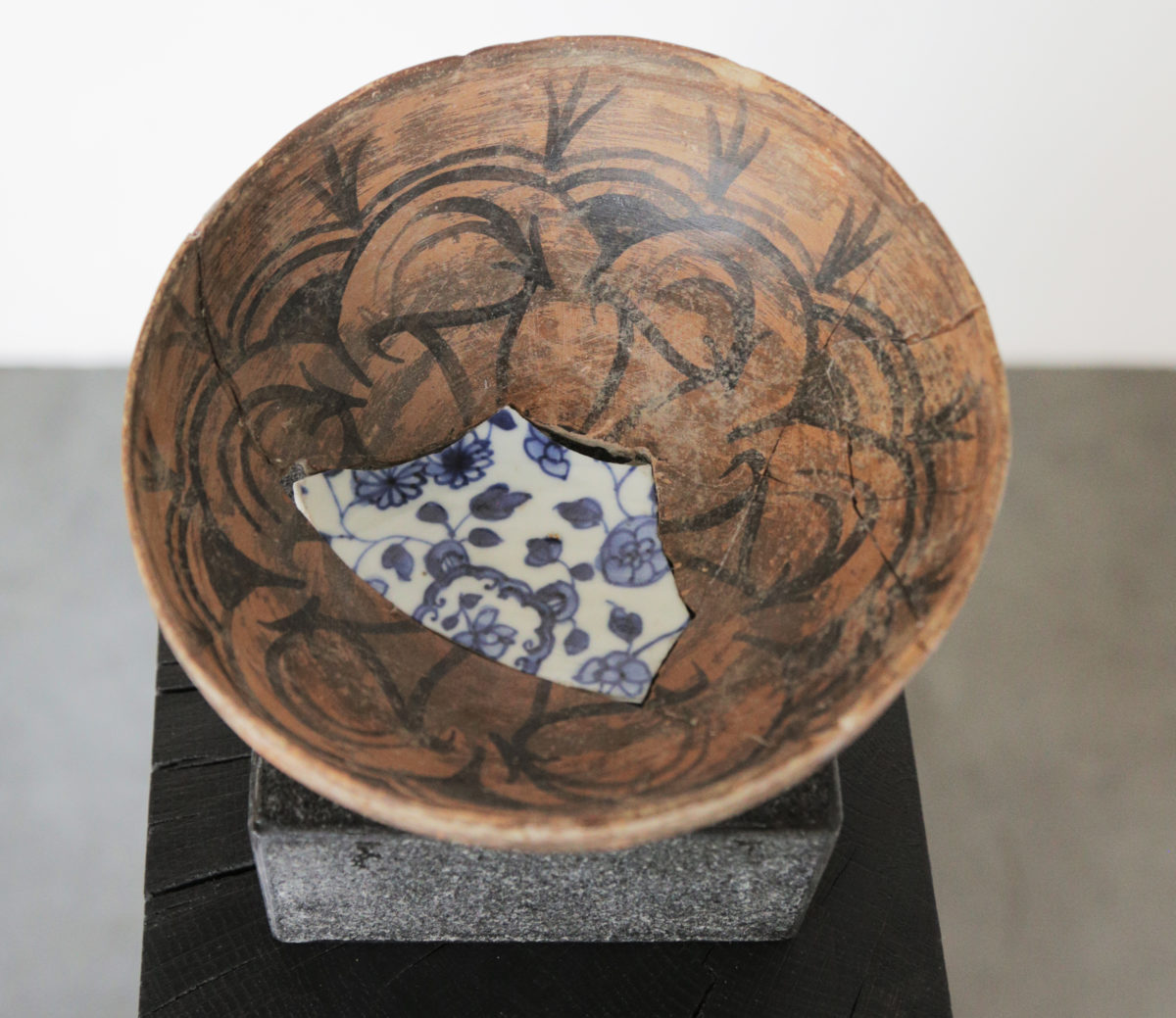
Ali Cherri, Hybrids (E), 2018.
Indus Valley painted terracotta bowl, porcelain fragment, granite base
18 x 12 x 6 cm. Unique
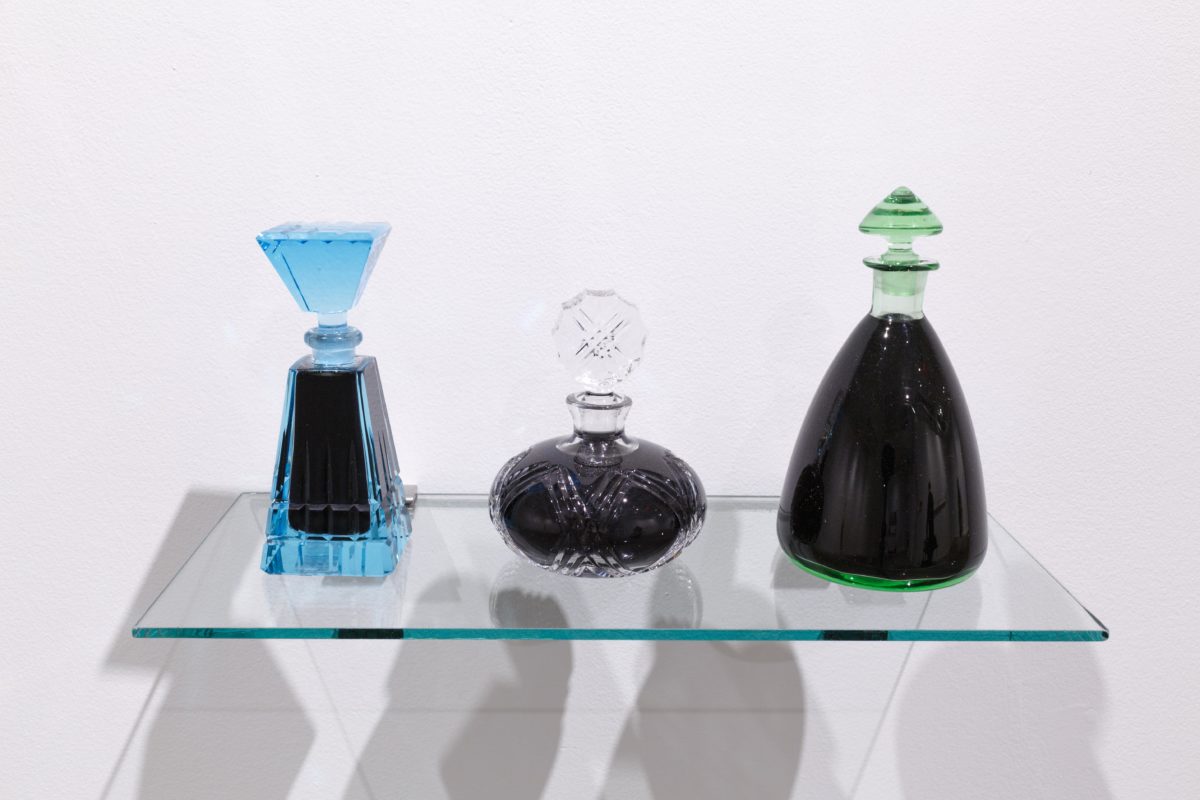
James Webb, I do not live in this world alone, but in a thousand worlds (A Comet is Coming), 2018.
Three texts written on soluble paper, dissolved in water, and presented in 3 glass vials (found objects)
20 x 40 x 18 cm. Unique
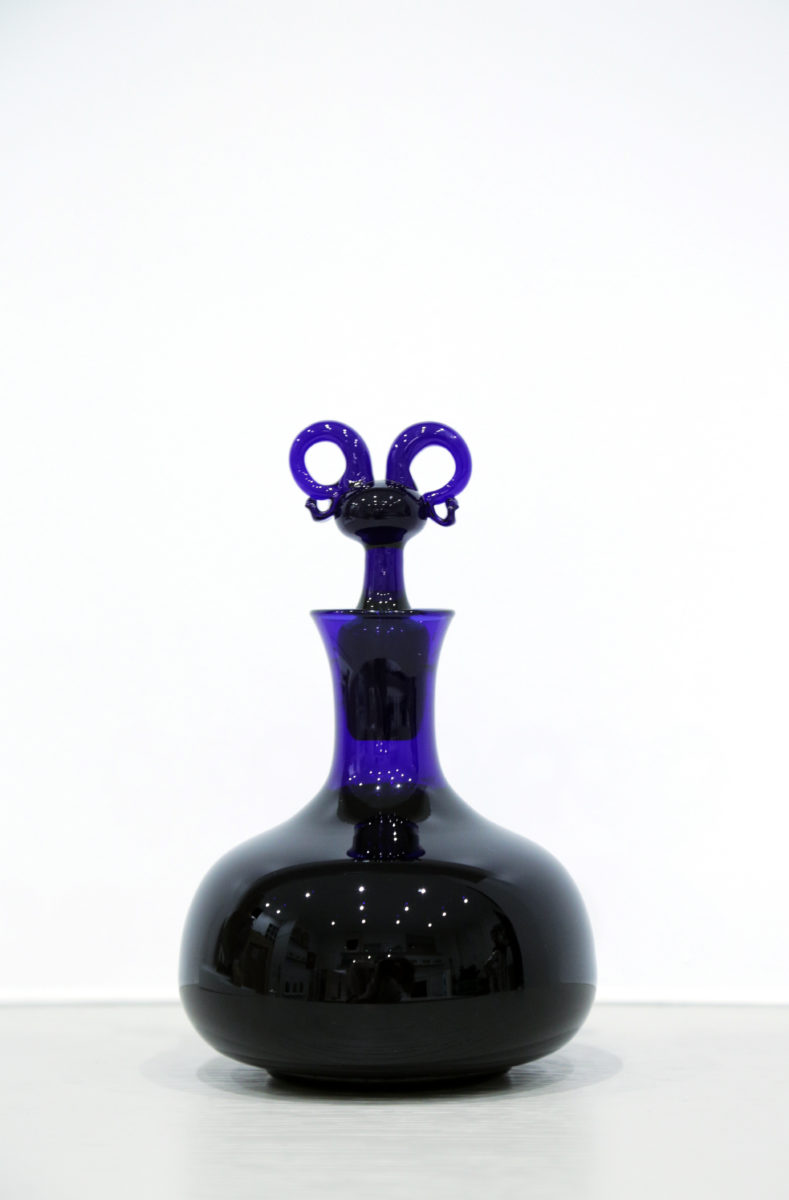
James Webb, I do not live in this world alone, but in a thousand worlds (Alma’s story), 2019.
One text written on soluble paper, dissolved in water, and presented in a glass vial (found object)
16 x 10 (diam.) cm. Unique
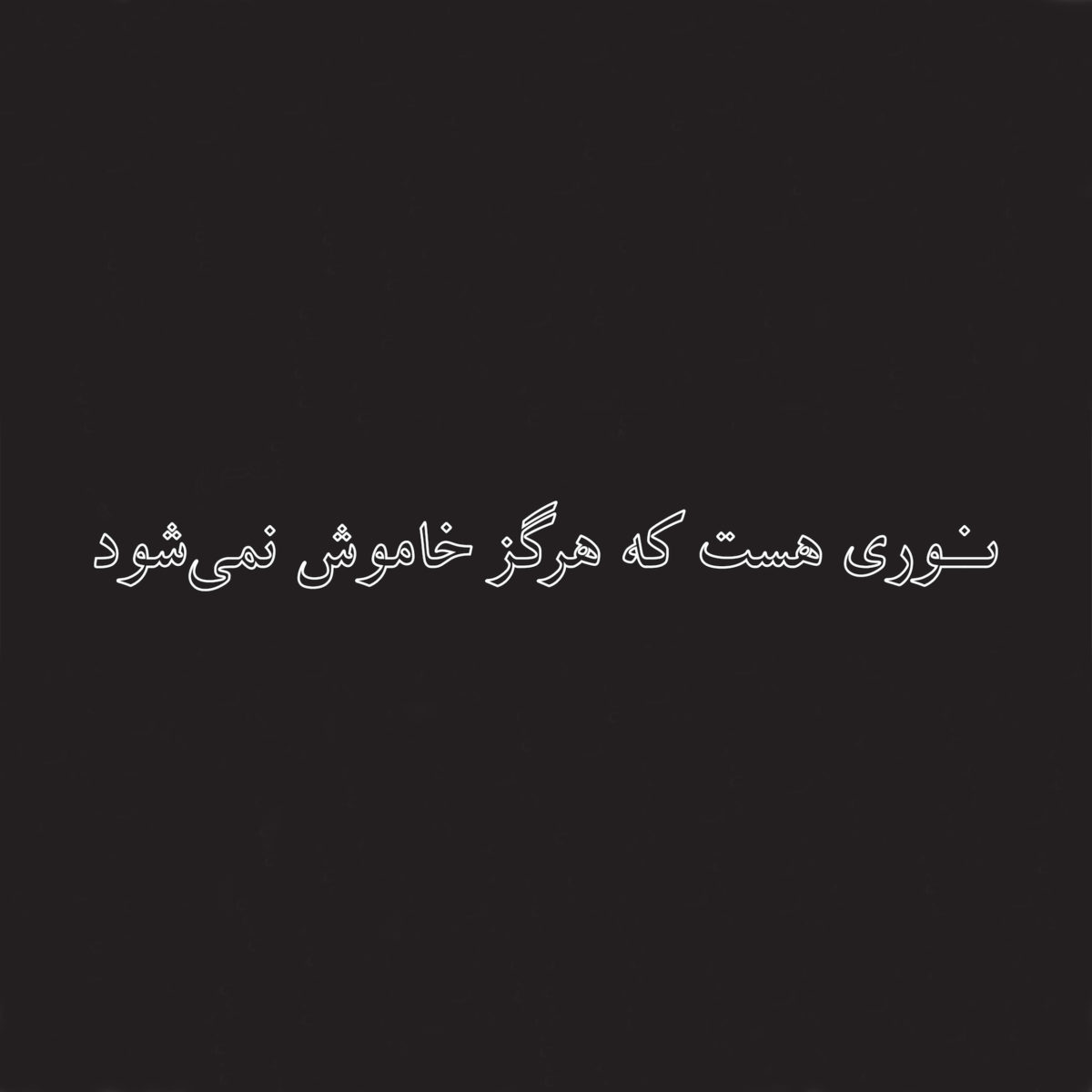
James Webb, There is a light that never goes out (Farsi), 2020.
8mm glass tubing in ‘sky white’
Site-specific / 30 x 300 cm approx. Edition of 1 + 1 AP. Available: 1/1

Sammy Baloji. Hans Himmelheber, The long building of the circumcision camp can be seen behind the mask, DR Congo, Pende region, 1939, scan of the inside of a Songye power figure, and your reflection in the mirror, 2020
UV Print on mirror 4 mm, frame in polished brushed brass
204 x 83 cm. Edition of 5 + 1 AP. Available: 1/5
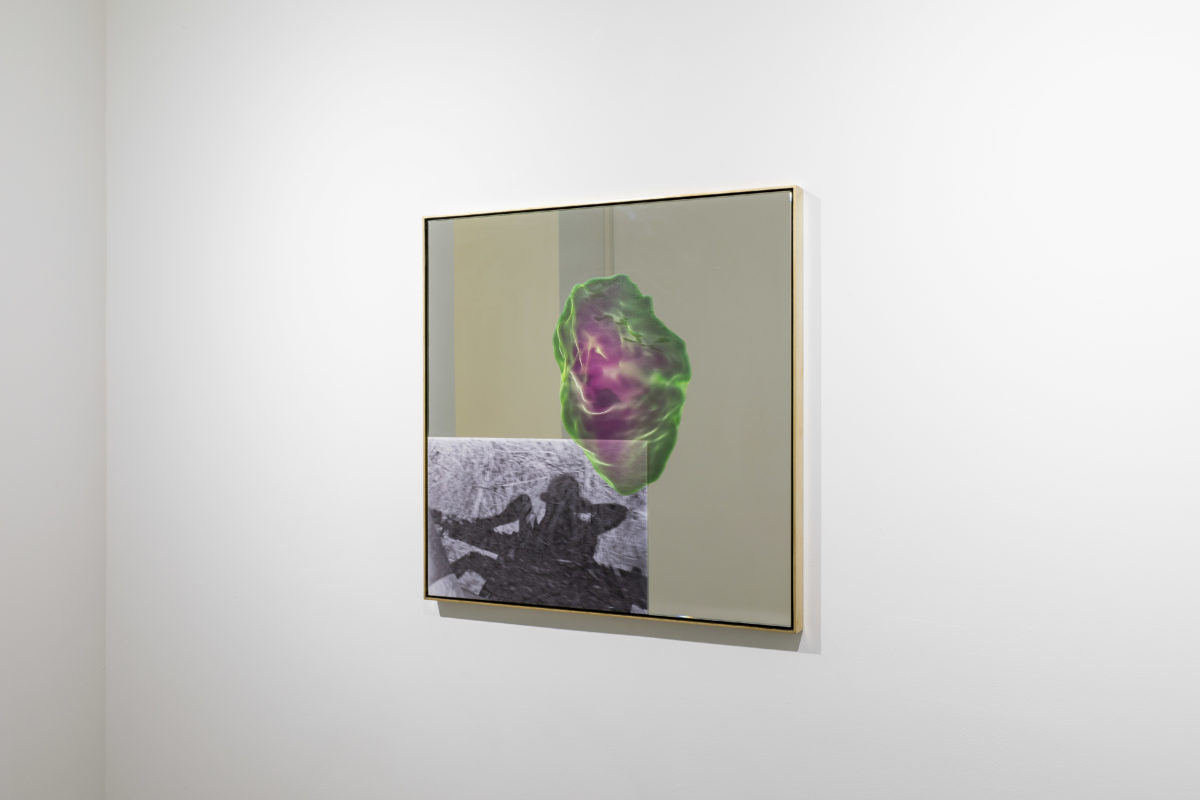
Sammy Baloji, Hans Himmelheber, Portrait of his shadow, DR Congo, Kingulu, June 18, 1938, scan of a Chalcopyrite from Kipushi mine, and your reflection in the mirror, 2020
UV Print on mirror 4 mm, frame in polished brushed brass
50 x 50 cm. Edition of 5 + 1 AP. Available: 3/5
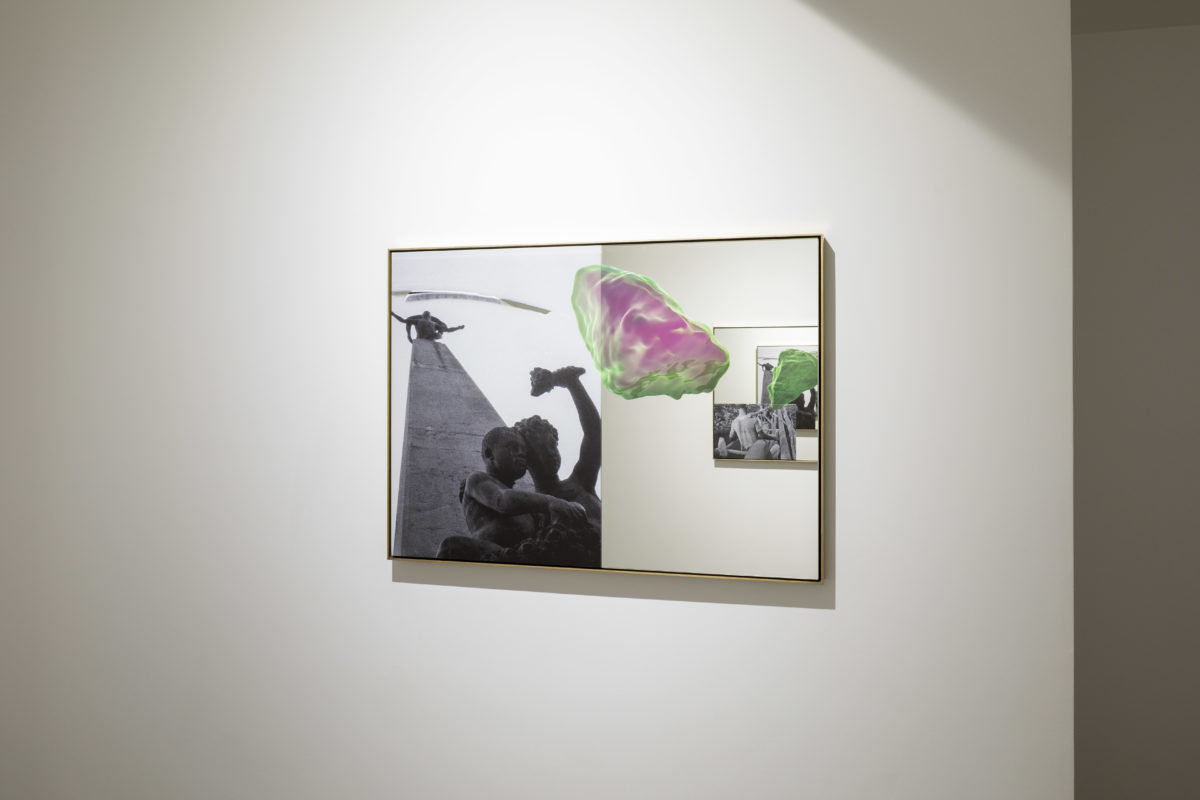
Sammy Baloji, Hans Himmelheber, Monument, DR Congo, Kinshasa, 1938, scan of a Chalcopyrite from Kipushi mine, and your reflection in the mirror, 2020
UV Print on mirror 4 mm, frame in polished brushed brass
50 x 70 cm. Edition of 5 + 1 AP. Available: 2/5
Graftings (A) – (J), 2018-2019
Variable dimensions
Unique
In agricultural botany, a graft is a sprout inserted into a slit on a trunk or stem of a living plant, from which it receives sap. In medicine, it’s a piece of living tissue that is transplanted surgically to replace diseased or injured tissue. Grafting is often used to create new varieties or species, and it can sometimes be made between different species, that is, human and animal.
By performing the assemblage of fragile things, a new appearance, a new life is granted.
These hybrids give us a glimpse into the power of matter. By looking at the life cycles of objects and the complexity of preservation and repre-sentation of matter, the relationships and tensions between the organic and synthetic, figurative and the abstract, the found and made object are revealed.
Grafting (G), Grafting (H), Grafting (I)
Exhibition view: Phantom Limb, Jameel Arts Centre, 2019
Grafting (I)
Exhibition view: Phantom Limb, Jameel Arts Centre, 2019
Grafting (H), Grafting (C)
Exhibition view: Phantom Limb, Jameel Arts Centre, 2019
Grafting (G)
Exhibition view: Phantom Limb, Jameel Arts Centre, 2019
Grafting (I)
Exhibition view: Phantom Limb, Jameel Arts Centre, 2019
Grafting (G), Grafting (H), Grafting (I)
Exhibition view: Phantom Limb, Jameel Arts Centre, 2019
Grafting (H)
Exhibition view: Phantom Limb, Jameel Arts Centre, 2019
Grafting (C)
Exhibition view: Phantom Limb, Jameel Arts Centre, 2019
Grafting (C)
Exhibition view: Phantom Limb, Jameel Arts Centre, 2019
Grafting (G), Grafting (H), Grafting (I)
Exhibition view: Phantom Limb, Jameel Arts Centre, 2019
Grafting (G),
Exhibition view: Phantom Limb, Jameel Arts Centre, 2019
Grafting (G), Grafting (H), Grafting (I)
Exhibition view: Phantom Limb, Jameel Arts Centre, 2019
Grafting (C)
Exhibition view: Phantom Limb, Jameel Arts Centre, 2019
Grafting (H), Grafting (I)
Exhibition view: Phantom Limb, Jameel Arts Centre, 2019
Grafting (H), Grafting (C)
Exhibition view: Phantom Limb, Jameel Arts Centre, 2019
Grafting (G), Grafting (H)
Exhibition view: Phantom Limb, Jameel Arts Centre, 2019
Grafting (I)
Exhibition view: Phantom Limb, Jameel Arts Centre, 2019
Grafting (I)
Exhibition view: Phantom Limb, Jameel Arts Centre, 2019
Grafting (G), Grafting (H)
Exhibition view: Phantom Limb, Jameel Arts Centre, 2019
Grafting (C)
Exhibition view: Phantom Limb, Jameel Arts Centre, 2019
Grafting (A)
Grafting (A)
Grafting (B)
Grafting (D)
Graftings (A) – (J), 2018-2019
Variable dimensions
Unique
In agricultural botany, a graft is a sprout inserted into a slit on a trunk or stem of a living plant, from which it receives sap. In medicine, it’s a piece of living tissue that is transplanted surgically to replace diseased or injured tissue. Grafting is often used to create new varieties or species, and it can sometimes be made between different species, that is, human and animal.
By performing the assemblage of fragile things, a new appearance, a new life is granted.
These hybrids give us a glimpse into the power of matter. By looking at the life cycles of objects and the complexity of preservation and repre-sentation of matter, the relationships and tensions between the organic and synthetic, figurative and the abstract, the found and made object are revealed.
Grafting (G), Grafting (H), Grafting (I)
Exhibition view: Phantom Limb, Jameel Arts Centre, 2019
Grafting (I)
Exhibition view: Phantom Limb, Jameel Arts Centre, 2019
Grafting (H), Grafting (C)
Exhibition view: Phantom Limb, Jameel Arts Centre, 2019
Grafting (G)
Exhibition view: Phantom Limb, Jameel Arts Centre, 2019
Grafting (I)
Exhibition view: Phantom Limb, Jameel Arts Centre, 2019
Grafting (G), Grafting (H), Grafting (I)
Exhibition view: Phantom Limb, Jameel Arts Centre, 2019
Grafting (H)
Exhibition view: Phantom Limb, Jameel Arts Centre, 2019
Grafting (C)
Exhibition view: Phantom Limb, Jameel Arts Centre, 2019
Grafting (C)
Exhibition view: Phantom Limb, Jameel Arts Centre, 2019
Grafting (G), Grafting (H), Grafting (I)
Exhibition view: Phantom Limb, Jameel Arts Centre, 2019
Grafting (G),
Exhibition view: Phantom Limb, Jameel Arts Centre, 2019
Grafting (G), Grafting (H), Grafting (I)
Exhibition view: Phantom Limb, Jameel Arts Centre, 2019
Grafting (C)
Exhibition view: Phantom Limb, Jameel Arts Centre, 2019
Grafting (H), Grafting (I)
Exhibition view: Phantom Limb, Jameel Arts Centre, 2019
Grafting (H), Grafting (C)
Exhibition view: Phantom Limb, Jameel Arts Centre, 2019
Grafting (G), Grafting (H)
Exhibition view: Phantom Limb, Jameel Arts Centre, 2019
Grafting (I)
Exhibition view: Phantom Limb, Jameel Arts Centre, 2019
Grafting (I)
Exhibition view: Phantom Limb, Jameel Arts Centre, 2019
Grafting (G), Grafting (H)
Exhibition view: Phantom Limb, Jameel Arts Centre, 2019
Grafting (C)
Exhibition view: Phantom Limb, Jameel Arts Centre, 2019
Grafting (A)
Grafting (A)
Grafting (B)
Grafting (D)
Hybrids (A) – (K), 2018
Variable dimensions
Unique
In agricultural botany, a graft is a sprout inserted into a slit on a trunk or stem of a living plant, from which it receives sap. In medicine, it’s a piece of living tissue that is transplanted surgically to replace diseased or injured tissue. Grafting is often used to create new varieties or species, and it can sometimes be made between different species, that is, human and animal.
By performing the assemblage of fragile things, a new appearance, a new life is granted.
These hybrids give us a glimpse into the power of matter. By looking at the life cycles of objects and the complexity of preservation and repre-sentation of matter, the relationships and tensions between the organic and synthetic, figurative and the abstract, the found and made object are revealed.
— Ali Cherri
Hybrid (A)
Hybrid (A)
Hybrid (I)
Hybrid (I)
Hybrid (I)
Hybrid (H)
Hybrid (H)
Hybrid (H)
Hybrid (G)
Hybrid (G)
Hybrid (F)
Hybrid (F)
Hybrid (F)
Hybrid (E)
Hybrid (E)
Hybrid (D)
Hybrid (D)
Hybrid (C)
Hybrid (C)
Hybrid (B)
Hybrid (B)
Hybrid (B)
Hybrid (B)
Hybrid (E), Hybrid (J), Hybrid (K)
Exhibition view © of Para Site. Photo: Eddie Lam, Image Art Studio
Hybrid (E), Hybrid (K), Hybrid (J)
Exhibition view © of Para Site. Photo: Eddie Lam, Image Art Studio
I do not live in this world alone, but in a thousand worlds, 2016
10 texts (by Maya Angelou, Ingrid Jonker, Roland Barthes, Yukio MIshima, Reinalso Arenas, William S. Burroughs, Tomas Tranströmer, Samuel Beckett, Dorothy Parker and The Cure) written on soluble paper, dissolved in water, and presented in 10 glass vials (found objects)
Various dimensions
Unique
Installation view: James Webb, Hope is a good swimmer, Imane Farès, Paris, 2017. Photo © Tadzio
I do not live in this world alone, but in a thousand worlds is a series of selected texts presented by the artist as philosophical medicines and poetic potions.
Each work is exhibited as an installation of glass vials, with each vial containing the liquid residue of a text that has been transcribed with ink on soluble paper and dissolved in water. Through this process the ink stains the water, and the water converts the paper to a thin, soft pulp, allowing for the initial page of writing to become a liquid solution. Committed to water, the text gains the possibility of entering the body through the mouth, in the style of a psychoactive drug or elixir. In this way, the words can be subsumed by the body, with the drinker able to possess and embody it, and be influenced from the inside. Dissolved, the ideas and images contained in the text have the agency to seep, stain, and spill. These transmuted texts, or ‘drowned anthologies’, oppose the idea of the permanence of the written record – whether on paper or in stone – and their transitory nature allows them the potential to shift and undergo subtle changes over time, so that the artwork is in a constant state of flux.
Each version of this artwork is unique in an evolving series.
I do not live in this world alone, but in a thousand worlds, 2016
10 texts (by Maya Angelou, Ingrid Jonker, Roland Barthes, Yukio MIshima, Reinalso Arenas, William S. Burroughs, Tomas Tranströmer, Samuel Beckett, Dorothy Parker and The Cure) written on soluble paper, dissolved in water, and presented in 10 glass vials (found objects)
Various dimensions
Unique
Installation view: James Webb, Hope is a good swimmer, Imane Farès, Paris, 2017. Photo © Tadzio
I do not live in this world alone, but in a thousand worlds is a series of selected texts presented by the artist as philosophical medicines and poetic potions.
Each work is exhibited as an installation of glass vials, with each vial containing the liquid residue of a text that has been transcribed with ink on soluble paper and dissolved in water. Through this process the ink stains the water, and the water converts the paper to a thin, soft pulp, allowing for the initial page of writing to become a liquid solution. Committed to water, the text gains the possibility of entering the body through the mouth, in the style of a psychoactive drug or elixir. In this way, the words can be subsumed by the body, with the drinker able to possess and embody it, and be influenced from the inside. Dissolved, the ideas and images contained in the text have the agency to seep, stain, and spill. These transmuted texts, or ‘drowned anthologies’, oppose the idea of the permanence of the written record – whether on paper or in stone – and their transitory nature allows them the potential to shift and undergo subtle changes over time, so that the artwork is in a constant state of flux.
Each version of this artwork is unique in an evolving series.
There is a light that never goes out (Arabic version), 2010
White neon
89 x 394 cm
Edition of 5 + 2 AP
There is a light that never goes out is an ongoing series of neon text works in which the title of the 1986 song by The Smiths is translated into selected languages. Fabricated in neon, the evocative lyric is transformed from its musical reference into a visual sign that conjures open-ended cultural and site-specific associations.
The original version of the artwork was commissioned for “Sentences On The Banks And Other Activities,” curated by Abdellah Karroum for the façade of Dar Khalid at the Darat al Funun in Amman, Jordan in 2010. This version is now a permanent installation on site.
Kasala, The Slaughterhouse of Dreams or the First Human, Bende’s Error, 2019
Installation includes a hunting horn with scarifications of the coppersmith Guido Clabots in Dinant, Belgium, copper (variable dimensions); mirrors with photos of Hans Himmelheber and X-ray topograms, UV print of glass, brass frame (202 x 85 cm each); a reproduction of an archival photograph from the Royal Museum for Central Africa, Tervuren; Kasala, HD video, color, sound, 30 min
Commissioned in 2019 by the Rietberg Museum in Zürich following a residency of the artist for the exhibition Congo as Fiction, the project, reconfigured and expanded with new productions, was subsequently presented at the Sydney Biennale, Imane Farès in Paris and the ARoS Museum in Aarhus, Denmark.
Exhibition views:
© Museum Rietberg Zürich, photo: Rainer Wolfsberger;
22nd Biennale of Sydney (2020), Cockatoo Island. Presented at the 22nd Biennale of Sydney with assistance from the Flemish Ministry of Culture. Photograph: Zan Wimberley.
Imane Farès, Paris, 2020. Photos © Tadzio
ARoS, Aarhus, 2021.
In his installation Kasala: The Slaughterhouse of Dreams or the First Human, Bende’s Error, the internationally renowned artist Sammy Baloji addresses Hans Himmelheber by questioning the way the West deals with colonial collections and archives: what happens to objects from Africa that have landed in museums of the global North, robbed of their original cultural context? In how far is it legitimate to expose the secret inner life of power figures? How can objects reclaim their voice? What alternative forms of remembrance are there?
The writer Fiston Mwanza Mujila composed a Luba-style commemorative poem (kasala) for Baloji’s installation in which he not only captures in poetic words the inhumanity of mining practices, but also goes in search of his own roots at the same time.
Lost and Found, a selection of works by Sammy Baloji, Ali Cherri and James Webb for FIAC Online Viewing Rooms.
The gallery’s Online Viewing Room